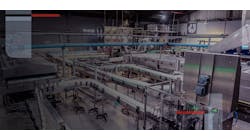As a result, one of the key architects is SugarCreek's chief information officer. Ed Rodden quickly points out he has spent as much time on the business side as on IT, and that he's no "IT guy."
He does, however, see the huge potential of data gathering and analysis at many more points than are taken advantage of by most companies. And he sees the new Indiana facility as a blank canvas on which to paint his vision of a futuristic food plant, one that uses that catchy phrase "industrial internet of things" (IIoT) to tie together the galaxy of sensors and other devices that make up many modern plants.
"To us, IIoT means the ability to use all the available pieces of data, including video and security, from all kinds of devices and to tie them all together in such a way that's useful to the business," he says.
Sugar Creek already was a Cisco customer before the processor embarked on the Cambridge City project. Before he started on the rehab, Rodden made a visit to Cisco's San Jose, Calif., headquarters, which opened his eyes to the potential breadth of tying all this data together in automated, immediate and actionable ways.
SugarCreek officials and IoT architects from Cisco Services analyzed the SugarCreek use cases and brainstormed technical solutions that would address the needs. The companies conducted technical proofs of concept and validated the ROI of the proposed platforms prior to deploying them. Cisco Services was responsible for program-managing the technology deployment at the factory.
Rodden and R.J. Mahadev, Cisco's IoT Service Solutions lead, will semi-literally "walk" attendees through a plant visit that contains some surprises in a presentation at the Smart Industry Conference & Expo Oct. 5-7 in Chicago. By the way, all the parenthetical references (CXS Architecture, IC, VSOM, etc.) refer to Cisco products that are explained in the glossary at the end of this story.
The night before
Their "plant tour scenario" starts the evening before a customer is scheduled to visit the facility. The plant manager receives a call at home from the second shift superintendent to explain an issue that arose at the plant.
To better explain, the superintendent opens a Webex session with the plant manager and shares video being captured (via CXS Architecture, Librestream) of the issue on the plant floor. "This allows the plant manager to fully understand the issue and give appropriate responses," Rodden explains.
That same evening, the salesperson who's bringing in the customer attempts to make contact with a night supervisor on a Jabber session from home to verify that all of the preparations are complete and the plant is ready. Getting no response, the salesperson calls the night supervisor on his radio (IC) and reaches him on the plant floor.
The supervisor grabs a VDI mobile device with video capability from the plant QA office, signs in, establishes a Jabber session with the salesperson and promotes the Jabber session to a Webex, taking the salesperson on a “walking tour” showing him that preparations are complete and everything is ready.
When they end the session, the salesperson schedules a greeting to be displayed in the lobby at the appropriate time using Digital Signage.
The morning of the visit
The plant manager has alerted security at the gate that a customer and salesperson will be arriving. He also sets up an event notice with physical security to send him a notification when the salesperson’s badge is read at the gate.
Upon their arrival at the gate, the salesperson checks in with the guard, who assigns a guest badge as an “in” swipe. That creates a guest account and prints a sticker with the login info to be attached to the badge.
The salesperson uses his card to open the gate, which triggers an email notification to the plant manager that they have arrived. This also triggers video surveillance to begin tracking the identity card of the salesperson (VSOM). Any time his card is read in an area, the surveillance footage is tagged allowing the plant manager to visually see where his visitors are.
The company's chairman decides to join the visit and arrives at the gate using his key card to enter. Once his presence is recognized, content from various media outlets he monitors is spun up to displays surrounding his desk and his local devices (ECDS). A notification is sent to the admin group at the plant notifying them that the chairman has arrived.
As the salesperson enters the lobby with his customer, the plant manager greets them and gets them temporary security badges, which also makes the visitors visible to RTLS. If the plant manager had been delayed, the visitors would have used a Jabber-driven kiosk to notify the admin group of their arrival.
The customer is instructed that he may connect to a visitors' wireless network. ISE presents an acceptance page to the visitor to allow basic inspection of his wireless device and access to the internet through the plant's network. He accepts, the device meets the criteria and he is now connected.
The tour begins
After properly preparing with gowns, etc., they enter the plant floor to observe the process for the product the customer is buying. The customer's temporary card allows access to only the main office area, restrooms and certain other areas (CPAM), so he must be escorted by someone with access into other areas.
The customer observes high-performance work team displays placed strategically in the work area displaying the day's numbers and key process data and indicators (Digital Signage). He also notes the use of mobile devices in IP67-rated enclosures by team members to enter data as needed without leaving the floor or having to physically go to a fixed station.
Process data from the machines and sensors are being captured through CPwE the network, integrated but isolated (ISE) with the data readily available. The customer asks about access to process data, and the plant manager demonstrates access through one of the team's mobile devices.
The plant manager sends a note to IT from his iPad requesting read-only access to the process data set for the customer. An IT developer will spin up an isolated server and create a service to populate the process data of interest to the customer (UCS) also setting up his access in the process. The customer will receive an email with instructions before he leaves the facility that day.
At this point in the tour, an alarm has indicated to the plant safety team that a pressure drop occurred in an ammonia line within the facility. The line is monitored by sensors integrated through MSE. VSOM triggers the automatic recording of video, and a predetermined amount of prior video is tagged to save.
The safety team leader determines the current direction of the prevailing wind using a network sensor (integrated through MSE) and triggers an evacuation notice broadcast to all devices (radios, phones, etc., via Informacast/IC) including that of the customer. The notice instructs them of the exit direction they should take, and directions also are displayed on monitors throughout the facility (Digital Signage.)
All doors are unlocked (CPAM) and non-essential devices powered down.
The team leader evacuates with his mobile device using MSE/RTLS to monitor the evacuation. A dynamic display of rooms where motion is occurring is accessible to the team leader. As the evacuation progresses, he notices an employee who has not left his area and also notes that he has a radio assigned to him. He contacts him (IC) and learns he was powering down a device and is now leaving the area in the proper direction.
An emergency response team, properly equipped, has determined there is no leak – it was a faulty sensor. So the team notifies the safety team leader via his radio (IC), who, still outside, triggers a new broadcast notice (Informacast/IC) to all advising that the evacuation has ended and that everyone should report to their normal stations. Digital Signage provides a notice that all is clear.
The customer, salesperson and plant manager return to the office area and enter the main conference room. Lights, coffee maker and video conference device all spring to life as their presence is detected (MSE/RTLS/CPAM.)
They review the day's activities and action plan, and the customer records and files his report with his home office using his mobile device, which he has connected through ISE.
He turns in his badge as they leave the facility. The guard does an exit swipe of the badge that triggers the shutdown of all connections and privileges related to the guest badge.
The plant manager finishes his day with a quick review of energy consumption (Cisco Energy Management/CPAM). As he leaves his office, the lights go out, his stationary office devices power down and he heads for home.
Glossary
Secure Automation Solutions
CPwE: Converged Plant wide Ethernet: An integrated Industrial Automation and Control System architecture (IACS) jointly developed by Cisco & Rockwell Automation to help accelerate the successful deployment of standard networking technologies and the convergence of manufacturing and enterprise/business networks.
ISE: Identity Services Engine: A leading program for end-user identity management on your wireless & wired networks. Automate & enforce access to network resources based on the user & the resource being accessed. Widely used to manage what employees & guests can access through plant Wi-Fi and network ports.
Location Solutions:
CMX: Connected Mobile Experiences: Uses a Wi-Fi network and location intelligence from the Mobility Services Engine (MSE) to create personalized mobile experiences for mobile end users and gain operational efficiency with location-based services... Allows customers to tap into users connected lifestyle and provide relevant mobile content while gaining meaningful analytics.
MSE: Mobility Services Engine:An application platform to extend a Wi-Fi network to not only provide connectivity but also to provide innovative mobile services and improve business processes. This includes increased visibility into the network, location-based mobile services, and stronger security. The Connected Mobile Experiences (CMX) application and the Wireless Intrusion Prevention System (wIPS) are hosted on the MSE.
wIPS: Wireless Intrusion Prevention System A complete wireless security solution that uses the Cisco Unified Access™ infrastructure to detect, locate, mitigate, and contain wired and wireless rogues and threats at Layers 1 through 3. Integration of wIPS into the WLAN infrastructure offers cost and operational efficiencies delivered by using a single infrastructure for both wIPS and WLAN services.
Analytics Solutions
CEM: Cisco Energy Manager: (Formerly EnergyWise): Cisco platform for monitoring & managing energy consumption of IT & plant floor equipment.
UCS: Unified Computing System: An x86 architecture data center server platform composed of computing hardware, virtualization support, switching fabric, and management software targeted at reducing total cost of ownership and improve scalability by integrating the different components into a cohesive platform that can be managed as a single unit.
VSOM: Video Surveillance Operations Manager A web-based toolkit for configuration, management, display, and control of video from a wide variety of both Cisco and third-party surveillance endpoints. The platform quickly and effectively configures and manages video throughout the enterprise, meeting the diverse needs of administrators, systems integrators, and operators.
Collaboration Solutions
CXS: Capture-Transform-Share: Platform from Cisco focused on transforming workflows & processes with interactive Video technology
CPAM: Cisco Physical Access Manager Management application for the Cisco Physical Access solution. Its easy-to-use interface lets you configure Cisco Physical Access gateways and modules, monitor activity, enroll users, and integrate with IT applications and data stores
Digital Signage: Portfolio of Cisco products that include Digital Media Players (DMPs), Content Delivery solutions, Interactive Media Management & a Content Ecosystem.
ECDS: Enterprise Content Delivery Services: A suite of content management applications including A Service Engine, a Content Acquirer, A Service Router & a manager to ensure optimum delivery of content irrespective of the underlying media.
IC: Instant Connect (Formerly IPICS--Interoperability and Collaboration System): A platform to simplify radio dispatch operations and improve response to incidents, emergencies, and facility events. Integrates radios, mobile phones, landline phones, IP phones, and PCs, to support communications across users, devices, and locations
Jabber: A unified Instant Messaging (IM) platform that lets you manage access presence, voice, video, voice messaging, desktop sharing, and conferencing through a single interface. Widely deployed in enterprise environments to right people, see if and how they are available, and collaborate using preferred communication methods.
VDI: Virtual Desktop Infrastructure: A means for enabling a bring-your-own-device (BYOD) approach to client computing while offering increased security and resiliency of corporate data and enabling new work styles that transcend the limits and geographical boundaries of the traditional user work environment. The solution encompass myriad components that reliably delivers an uncompromised end-user experience that is secure and manageable and does not degrade as it scales.
WebEx: An on-demand collaboration, online meeting, web conferencing and videoconferencing application.
Industry Terminology
HPWT: High Performance Work Teams: A concept within organization development referring to teams, organizations, or virtual groups that are highly focused on their goals and that achieve superior business results. High-performance teams outperform all other similar teams and they outperform expectations given their composition
IP67: International Protection Level 67 Part of the IEC standard 60529, sometimes interpreted as Ingress Protection Marking, that classifies and rates the degree of protection provided against intrusion (body parts such as hands and fingers), dust, accidental contact, and water by mechanical casings and electrical enclosures. The first digit (6) signifies the level of solid particle protection (6, the highest, means ‘dust tight;--no ingress of dust; complete protection against contact). The second digit (7) signifies the level of liquid ingress protection (7, one of the highest, means ‘immersion up to 1m)nah.
RTLS: Real Time Locating Systems: Platforms used to automatically identify and track the location of objects or people in real time, usually within a building or other contained area. Wireless RTLS tags are attached to objects or worn by people, and Wi-Fi networks receive wireless signals from tags to determine their location.



